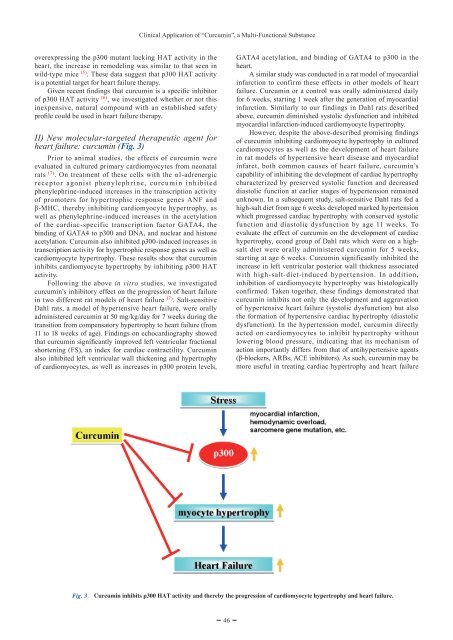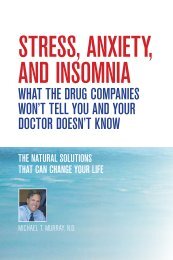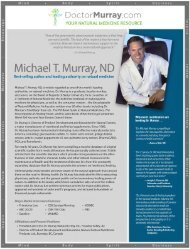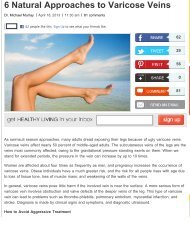Theracurmin Review - Dr. Michael Murray
Theracurmin Review - Dr. Michael Murray
Theracurmin Review - Dr. Michael Murray
You also want an ePaper? Increase the reach of your titles
YUMPU automatically turns print PDFs into web optimized ePapers that Google loves.
Clinical Application of “Curcumin”, a Multi-Functional Substance<br />
overexpressing the p300 mutant lacking HAT activity in the<br />
heart, the increase in remodeling was similar to that seen in<br />
wild-type mice 15) . These data suggest that p300 HAT activity<br />
is a potential target for heart failure therapy.<br />
<br />
of p300 HAT activity 16) , we investigated whether or not this<br />
inexpensive, natural compound with an established safety<br />
<br />
II) New molecular-targeted therapeutic agent for<br />
heart failure: curcumin (Fig. 3)<br />
Prior to animal studies, the effects of curcumin were<br />
evaluated in cultured primary cardiomyocytes from neonatal<br />
rats 17) <br />
receptor agonist phenyleph r ine, cu rcu min inhibited<br />
phenylephrine-induced increases in the transcription activity<br />
of promoters for hypertrophic response genes ANF and<br />
<br />
well as phenylephrine-induced increases in the acetylation<br />
of the cardiac-specific transcription factor GATA4, the<br />
binding of GATA4 to p300 and DNA, and nuclear and histone<br />
acetylation. Curcumin also inhibited p300-induced increases in<br />
transcription activity for hypertrophic response genes as well as<br />
cardiomyocyte hypertrophy. These results show that curcumin<br />
inhibits cardiomyocyte hypertrophy by inhibiting p300 HAT<br />
activity.<br />
Following the above in vitro studies, we investigated<br />
curcumin’s inhibitory effect on the progression of heart failure<br />
in two different rat models of heart failure 17) . Salt-sensitive<br />
Dahl rats, a model of hypertensive heart failure, were orally<br />
administered curcumin at 50 mg/kg/day for 7 weeks during the<br />
transition from compensatory hypertrophy to heart failure (from<br />
11 to 18 weeks of age). Findings on echocardiography showed<br />
<br />
shortening (FS), an index for cardiac contractility. Curcumin<br />
also inhibited left ventricular wall thickening and hypertrophy<br />
of cardiomyocytes, as well as increases in p300 protein levels,<br />
GATA4 acetylation, and binding of GATA4 to p300 in the<br />
heart.<br />
A similar study was conducted in a rat model of myocardial<br />
infarction to confirm these effects in other models of heart<br />
failure. Curcumin or a control was orally administered daily<br />
for 6 weeks, starting 1 week after the generation of myocardial<br />
infarction. Similarly to our findings in Dahl rats described<br />
above, curcumin diminished systolic dysfunction and inhibited<br />
myocardial infarction-induced cardiomyocyte hypertrophy.<br />
<br />
of curcumin inhibiting cardiomyocyte hypertrophy in cultured<br />
cardiomyocytes as well as the development of heart failure<br />
in rat models of hypertensive heart disease and myocardial<br />
infarct, both common causes of heart failure, curcumin’s<br />
capability of inhibiting the development of cardiac hypertrophy<br />
characterized by preserved systolic function and decreased<br />
diastolic function at earlier stages of hypertension remained<br />
unknown. In a subsequent study, salt-sensitive Dahl rats fed a<br />
high-salt diet from age 6 weeks developed marked hypertension<br />
which progressed cardiac hypertrophy with conserved systolic<br />
function and diastolic dysfunction by age 11 weeks. To<br />
evaluate the effect of curcumin on the development of cardiac<br />
hypertrophy, econd group of Dahl rats which were on a highsalt<br />
diet were orally administered curcumin for 5 weeks,<br />
starting at age 6 weeks. Curcumin significantly inhibited the<br />
increase in left ventricular posterior wall thickness associated<br />
with high-salt-diet-induced hypertension. In addition,<br />
inhibition of cardiomyocyte hypertrophy was histologically<br />
confirmed. Taken together, these findings demonstrated that<br />
curcumin inhibits not only the development and aggravation<br />
of hypertensive heart failure (systolic dysfunction) but also<br />
the formation of hypertensive cardiac hypertrophy (diastolic<br />
dysfunction). In the hypertension model, curcumin directly<br />
acted on cardiomyocytes to inhibit hypertrophy without<br />
lowering blood pressure, indicating that its mechanism of<br />
action importantly differs from that of antihypertensive agents<br />
<br />
more useful in treating cardiac hypertrophy and heart failure<br />
Fig. 3.<br />
Curcumin inhibits p300 HAT activity and thereby the progression of cardiomyocyte hypertrophy and heart failure.<br />
46






